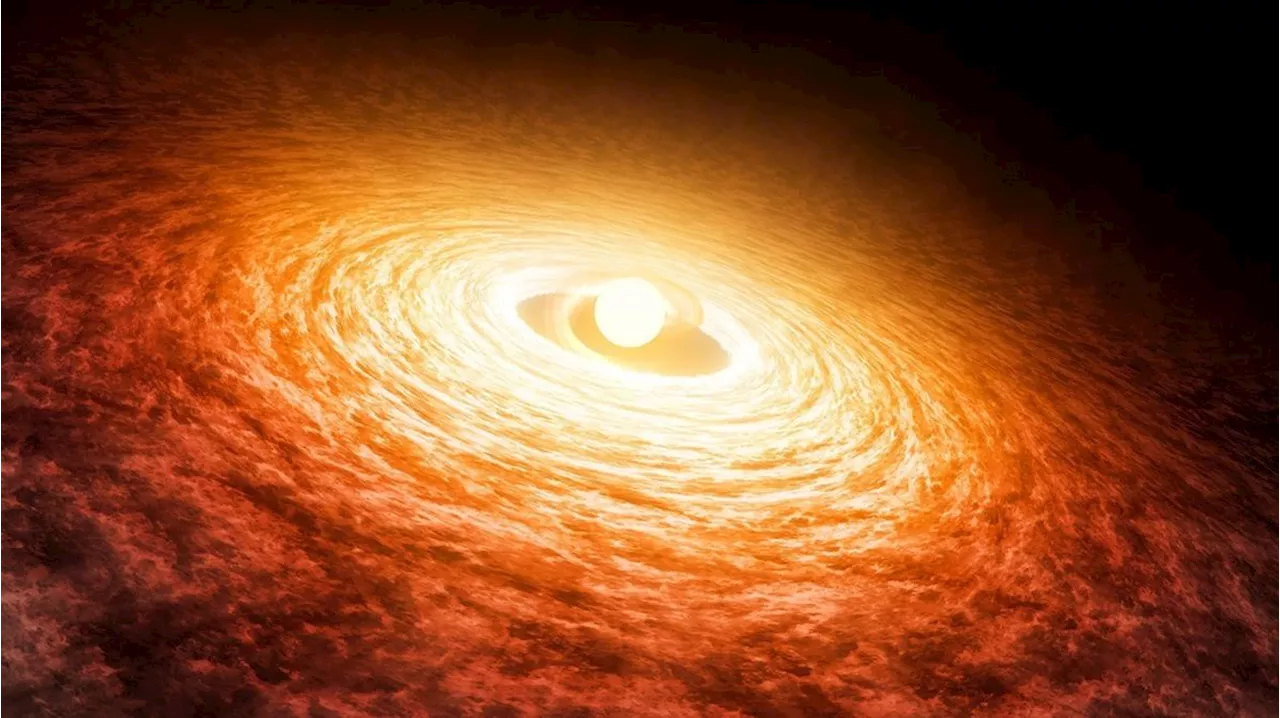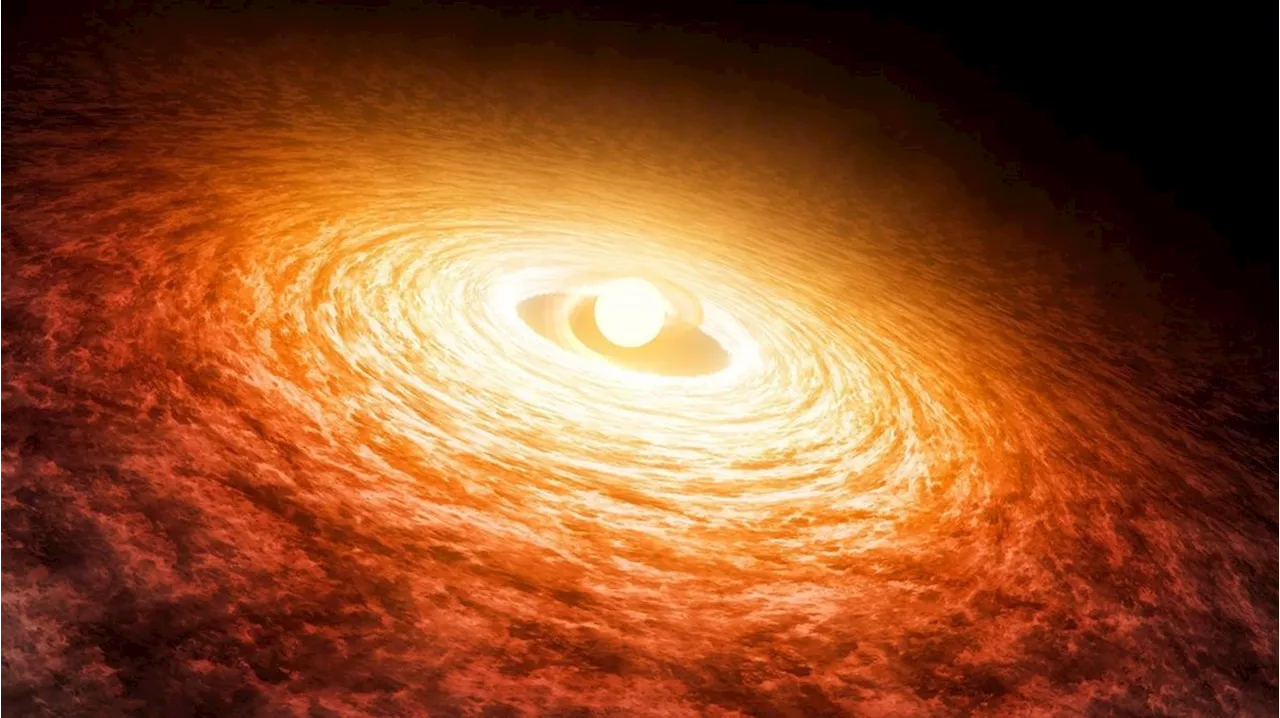A team of astronomers has used the Hubble Space Telescope to study FU Orionis, a young star in the Orion constellation that dramatically brightened in 1936. The star, part of a binary system and surrounded by a circumstellar disk, has been increasing in brightness for nearly 90 years due to its accretion of mass from the disk. This study provides insights into the interaction between its surface and the accretion process, making FU Orionis a namesake for a class of variable young stars.
This is an artist's concept of the early stages of the young star FU Orionis outburst, surrounded by a disk of material. A team of astronomers has used the Hubble Space Telescope 's ultraviolet capabilities to learn more about the interaction between FU Ori's stellar surface and the accretion disk that has been dumping gas onto the growing star for nearly 90 years. NASA-JPL, Caltech
FU Ori stars are T-Tauri stars that represent the most actively accreting young stellar objects . The outward magnetic pressure from T-Tauri stars prevents the disk from touching the star. Astronomers think that classical T-Tauri stars accrete material along their magnetic field lines and deposit on the poles in a process calledThis schematic shows how magnetospheric accretion works on T-Tauri stars. Image Credit: Adapted from Hartmann et al. .
“We were hoping to validate the hottest part of the accretion disk model, to determine its maximum temperature, by measuring closer to the inner edge of the accretion disk than ever before,” said Lynne Hillenbrand of Caltech in Pasadena, California, a co-author of the paper. “I think there was some hope that we would see something extra, like the interface between the star and its disk, but we were certainly not expecting it.
That means that the scientific model of FU Ori stars, called the viscous disk accretion model, needs to be updated. The team’s revised model says that as material from the accretion disk approaches the star and reaches its surface, it produces a hot shock that emits ultraviolet light. The temperature of the shock suggests that the material is moving at 40 km/s at the boundary, which is in line with simulations of the accretion process.
FU Orionis Hubble Space Telescope Accretion Disk Astronomers Orion Constellation Variable Young Stars
United States Latest News, United States Headlines
Similar News:You can also read news stories similar to this one that we have collected from other news sources.
 Art of the City: Crafting young minds a priority for visual artist Meera RamanathanThe San Diego elementary school teacher says artistic validation is the most important lesson for her students
Art of the City: Crafting young minds a priority for visual artist Meera RamanathanThe San Diego elementary school teacher says artistic validation is the most important lesson for her students
Read more »
 The Hubble and FU Orionis: a New Look at an Old MysteryFU Orionis and stars of its kind flare brightly in UV. New Hubble observations shed light on what's happening with these young stars.
The Hubble and FU Orionis: a New Look at an Old MysteryFU Orionis and stars of its kind flare brightly in UV. New Hubble observations shed light on what's happening with these young stars.
Read more »
 Documentary ‘The Young Vote’ Introduces America to the Young People Shaping Its FutureDocumentary ‘The Young Vote’ by Diane Robinson (Teach for America Alum) on PBS Introduces America to the Young People Shaping Its Future
Documentary ‘The Young Vote’ Introduces America to the Young People Shaping Its FutureDocumentary ‘The Young Vote’ by Diane Robinson (Teach for America Alum) on PBS Introduces America to the Young People Shaping Its Future
Read more »
 9 ways young people can reduce their cancer risk: 'Nobody's ever too young for cancer'Researchers explain this in a new study published in CA: A Cancer Journal for Clinicians that whilst genetics and environmental factors do play a role in cancer development, quitting smoking, watching your weight, using sun protection and drinking less can also help. Veuer’s Chloe Hurst has the story.
9 ways young people can reduce their cancer risk: 'Nobody's ever too young for cancer'Researchers explain this in a new study published in CA: A Cancer Journal for Clinicians that whilst genetics and environmental factors do play a role in cancer development, quitting smoking, watching your weight, using sun protection and drinking less can also help. Veuer’s Chloe Hurst has the story.
Read more »
 Youth Vote in 2024 Saw Young Men Vote for Trump, Young Women of Color Back HarrisThe 2024 election saw lower youth turnout and a swing towards Trump for young men. Here’s what to know.
Youth Vote in 2024 Saw Young Men Vote for Trump, Young Women of Color Back HarrisThe 2024 election saw lower youth turnout and a swing towards Trump for young men. Here’s what to know.
Read more »
 I'm Too Young to Vote, But Not Too Young to Die From Gun ViolenceLily Eng, 16, is the chapter lead of March For Our Lives Woodson High School in Fairfax, Virginia.
I'm Too Young to Vote, But Not Too Young to Die From Gun ViolenceLily Eng, 16, is the chapter lead of March For Our Lives Woodson High School in Fairfax, Virginia.
Read more »
